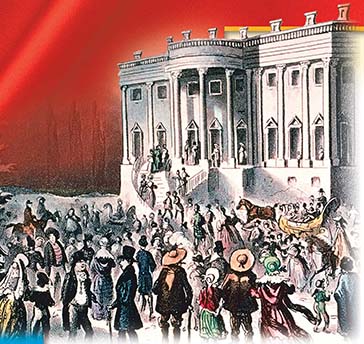SECTION 4: Democracy and the Age of Jackson

▲ A crowd gathers for Jackson’s inauguration

Plate celebrating President Jackson ►
WITNESS HISTORY  AUDIO
AUDIO
The “People’s President”
After a disappointing loss in the election of 1824, Andrew Jackson rode a wave of popular support to the presidency in 1828. At his inauguration, many of those same voters caused a wild scene at the White House when they arrived in large numbers to celebrate the historic event.
“Ladies fainted, men were seen with bloody noses and such a scene of confusion took place as is impossible to describe…. But it was the People’s day, and the People’s President, and the People would rule.”
—Margaret Bayard Smith in a letter to Mrs. Kirkpatrick, March 11, 1829
Objectives
- Analyze the movement toward greater democracy and its impact.
- Describe the personal and political qualities of Andrew Jackson.
- Summarize the causes and effects of the removal of Native Americans in the early 1800s.
Terms and People
- caucus
- Andrew Jackson
- Martin Van Buren
- Jacksonian Democracy
- spoils system
- Indian Removal Act
- Trail of Tears
NoteTaking
Reading Skill: Understand Effects Use a flowchart like the one below to record the effects of Jackson’s presidency.

Andrew Jackson’s Presidency
Why It Matters The election of 1824 signaled a shift in American political and social life. As a new political party emerged, the nation expanded its concept of democracy in some ways and narrowed it in others. The era became known for one of American history’s towering and controversial figures—Andrew Jackson. Section Focus Question: What changes did Andrew Jackson represent in American political life?
The Election of 1824
As the presidential election of 1824 approached, two-term President James Monroe announced that he would not seek a third term. As you have read, his presidency was marked by what appeared to be general political harmony. There was only one major political party, and the nation seemed to be united in its purpose and direction. Beneath this surface, however, there were differences. These would become obvious in the election of 1824.
A Four-Way Race
Four leading Democratic Republicans hoped to replace Monroe in the White House. John Quincy Adams, Monroe’s Secretary of State, offered great skill and experience. A caucus of Democratic Republicans in Congress preferred William Crawford of Georgia. A caucus is a closed meeting of party members for the purpose of choosing a candidate. War hero Andrew Jackson of Tennessee and Henry Clay of Kentucky provided greater competition for Adams.




